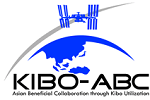This is an archive of information released in the past.
Disclaimer: It may contain broken links or outdated information. Some parts may not function in current web browsers.
*Visit https://humans-in-space.jaxa.jp/en/ for the latest information.

Asian Try Zero-G 2018 Experiment Ideas Selected

Kibo-ABC called for the proposal of a simple space experiment (for "Asian Try Zero-G 2018") to be conducted by JAXA astronaut Norishige Kanai onboard the International Space Station (ISS)/Kibo. As a result, 169 experiment proposals were submitted from 361 students and young engineers/researchers in Asian countries.
As the first step in the selection process, these proposals were screened by each Kibo-ABC member agency, with 26 proposals from seven Asian countries being recommended. These proposals were selected by various specialists in each country. For example in Malaysia, the selection process was conducted by the committee members consisted of teacher from the Ministry of Education (MOE), researchers from the Ministry of Science, Technology and Innovation (MOSTI) and expert from university with experience in previous onboard Asian Try Zero-G experiments and Asian Parabolic Flight mission conducted by JAXA.

Asian Try Zero-G Selection Committee in Malaysia (Credit:ANGKASA)
Then the screened proposals were reviewed and discussed by all Kibo-ABC agencies to decide the onboard experiment candidates. JAXA specialists including JAXA astronauts with experience in previous onboard Asian Try Zero-G experiments also supported the final stage of the selection process.

Technical discussion with JAXA astronauts Kimiya Yui and Takuya Onishi, and space experiment experts.(Credit:JAXA)
The following illustrates the selected 8 experiment proposals. (12 proposals were selected, and similar experiments were combined.)
There are two big differences from the previous Asian Try Zero-G programs--the new participation of Japanese high school students and new opportunities to launch experiment tools to the ISS. Some launch tools are to be prepared by Asian proposers/Kibo-ABC agencies.
The experiments selected for "Asian Try Zero-G 2018"
| Title | Gyroscope & Tippe Top |
|---|---|
| Countries | Singapore /Philippines/Vietnam   |
| Experiment | To observe the reaction of the gyroscope when pressing it in one direction, while altering the center of gravity with an additional weight, and to also observe the movement of the Tippe Top.
(Credit:SSTA) (Credit:VAST/STI) |
| Title | Aircraft Stability |
|---|---|
| Countries | Singapore(2 proposals combined) |
| Experiment | To test the effect of 'teardrop' wings, and the effect of changing the neutral point of the aircraft.

(Credit:SSTA) |
| Title | Spinning Ring |
|---|---|
| Countries | Malaysia |
| Experiment | To rotate a ring around a stick like a hula hoop, and observe how the ring moves under zero-G conditions.
(Credit:ANGKASA) |
| Title | Paper Boomerang |
|---|---|
| Countries | Indonesia/Singapore  |
| Experiment | To observe the trajectories of boomerangs in zero-G.
(Credit:SSTA) 
(Credit:SSTA) 
(Credit:LAPAN) |
| Title | Balls inside Slinky |
|---|---|
| Countries | Thailand |
| Experiment | To observe how three balls move inside the Slinky when applying vibration and centrifugal force to the Slinky.
(Credit:NSTDA/GISTDA) |
| Title | Double-Layered Liquid Ball |
|---|---|
| Countries | Philippines |
| Experiment | To try to form a double ball using water and oil to check whether the double ball can be formed in zero-G.

(Credit:DOST-SEI) |
| Title | Paper Spring |
|---|---|
| Countries | Japan |
| Experiment | To observe the movement of a paper spring with weight attached to both ends in zero-G.

(Credit:JAXA) |
| Title | Wire Top |
|---|---|
| Countries | Japan |
| Experiment | To observe the movement of a rotating Wire Top, where it is well-known that a rotating pair of pliers in zero-G inverts its attitude upside-down.

(Credit:JAXA) |
The experiments are subject to change due to following technical coordination.
| Copyright 2007 Japan Aerospace Exploration Agency | Site Policy |
